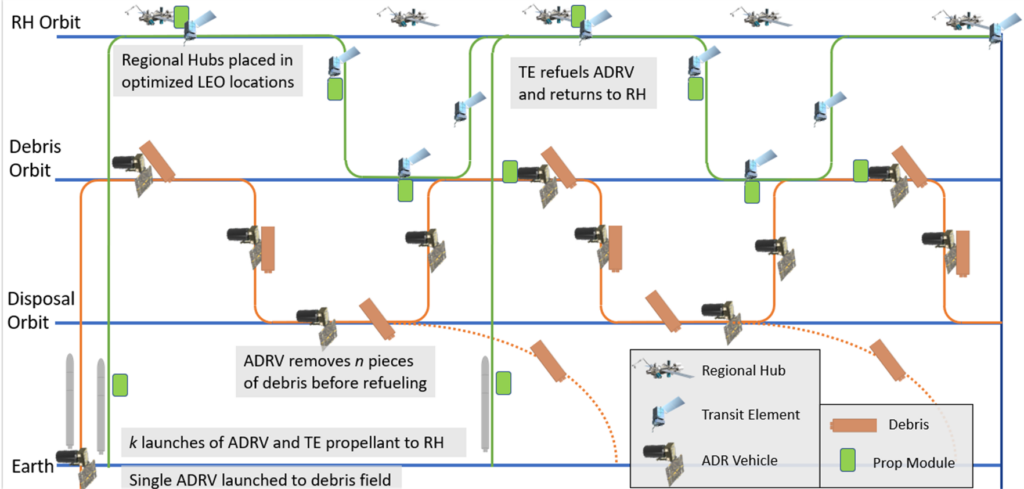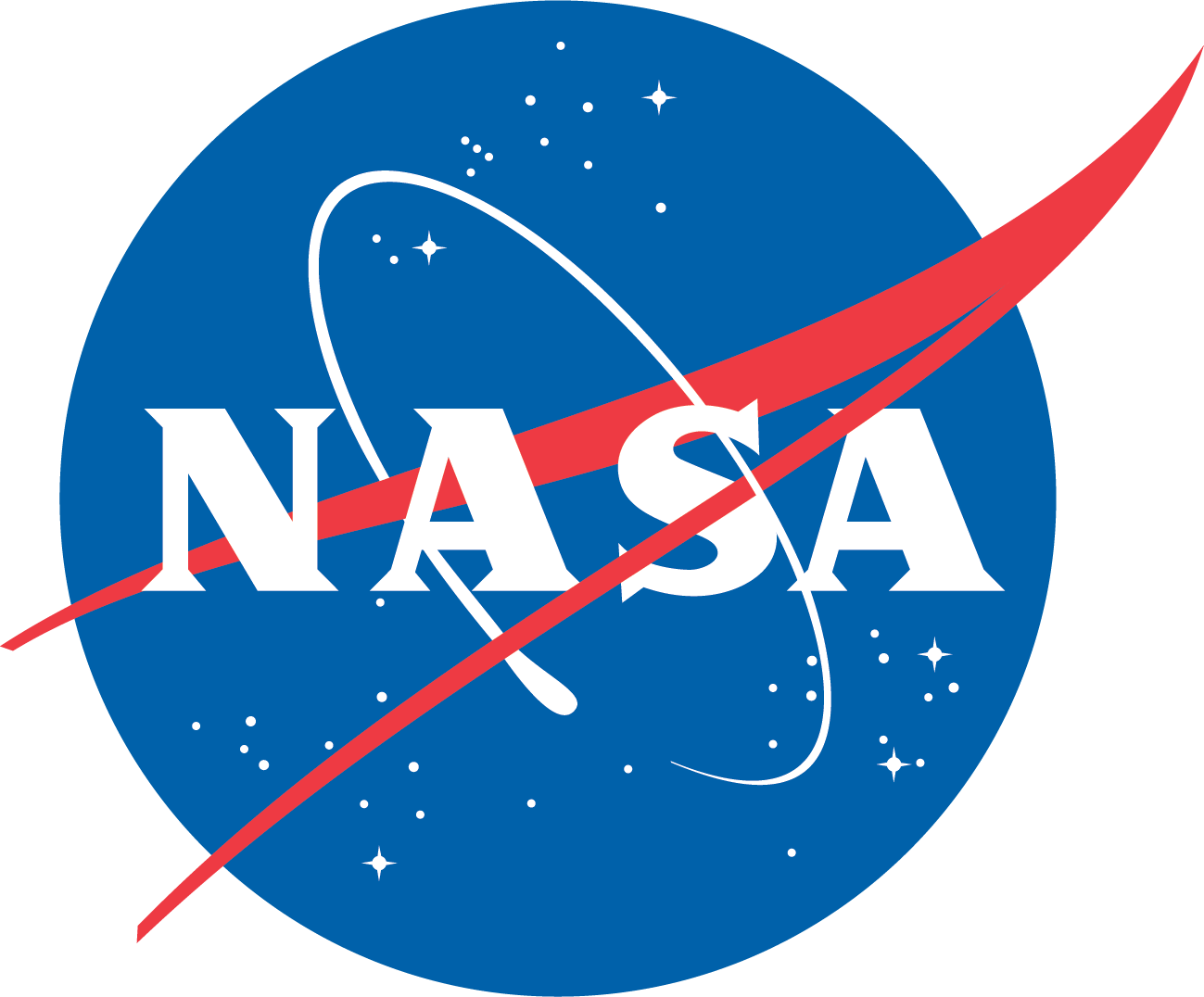The Space Superhighway

The Space Superhighway
A commercial-first space infrastructure
The Space Superhighway is a commercial-first space infrastructure that contains three primary components: regional hubs, a sustainable transportation network, and Earth-to-orbit logistics.
Civil, commercial, and national security space sectors could use this common infrastructure to support missions such as satellite servicing, Earth science, and space domain awareness, among others. It uses a commercial-first, “infrastructure-as-a-service” approach, which contains industry-owned and operated assets with government anchor tenants for commercial services, enabling extended mission lifetime, on-orbit repair, maneuver without regret, and debris mitigation and removal.
The Space Superhighway is the space infrastructure needed for the 21st century.
Background and Interagency Efforts
In 2018, NASA’s Langley Research Center and the Systems Analysis and Concepts Directorate (SACD) participated in the In-space Servicing, Assembly, and Manufacturing (ISAM) National Initiative, an interagency working group with the mission of stewarding the development of ISAM capabilities for United States government space activities.
In 2021, the Executive Office of the President requested that the working group develop a cohesive concept for space operations that support the U.S. tenants for civil and national security space. The study team, comprised of participants from several NASA centers (Langley, Goddard Space Flight Center, Marshall Space Flight Center, and NASA Headquarters), other government agencies (U.S. Space Force and the Air Force Research Lab), and the Aerospace Corporation, developed a concept for space infrastructure called the Space Superhighway, which could support civil, commercial, and national security space sectors.
This future concept, enabled by ISAM technologies, would promote science, in-space test and qualification, prototype evaluation, entrepreneurial applications, and robotic experiments.
Components of the Space Superhighway
Regional Hubs
- Establish strategic footholds in space
- Provide utilities to hosted payloads
- Provide refueling and services to the transportation network
- Serve as a regional logistics depot

Sustainable Transportation Network
- Provides rapid and responsive mobility
- Transports logistics between regional hubs
- Supports responsible disposal and debris mitigation
Earth-to-Orbit Logistics
- Fosters a competitive commercial launch industry
- Provides routine, low-cost access to space
Our Experience and Capabilities
The Systems Analysis and Concepts Directorate (SACD) is located at the NASA Langley Research Center in Hampton, VA and supports the future of aeronautics, exploration, space operations, and science.

As part of SACD, the Space Mission Analysis Branch (SMAB) serves as a premiere space concepts and systems analysis organization, enabling well-informed decision-making throughout NASA with integrated analysis and assessments of complex space systems, architectures, and portfolios based on benefit, cost, and risk. Through support of a broad set of agency customers, SMAB provides holistic insights within and across organizations that advance NASA’s human exploration and robotic scientific missions.
•We’ve analyzed concepts such as cis-lunar logistics and debris remediation
•We’ve established methods and tools for comparing space-logistics architectures
Our capabilities include:
•Trade space analysis
•Vehicle modeling and sizing
•Cost estimation
•Visualization
Learn more about our branch and meet our team by visiting our website.
Publications
The Space Superhighway: Enabling Active Debris Remediation Through an In-Space Logistics Infrastructure
John W. Mulvaney, Dale C. Arney, Benjamin A. Merrel and Daniel J. Tiffin
AIAA 2024-4899
Session: Orbital Debris: Challenges and Solutions
Published Online: 27 Jul 2024
https://arc.aiaa.org/doi/10.2514/6.2024-4899

The Space Superhighway is a future space infrastructure concept intended to support civil, commercial, and national security space interests by providing In-Space Servicing, Assembly, and Manufacturing (ISAM) services across low Earth orbit (LEO), geosynchronous orbit (GEO), and cislunar space. This concept was originally developed by an interagency working group and commissioned by the Executive Office of the President. The Space Superhighway is comprised of three primary components: regional hubs, a sustainable transportation network, and Earth-to-orbit logistics. This study establishes methods which may be used to quantify the cost-savings from use of the Space Superhighway infrastructure and interrogates the effects of the use of this logistics network on a specific use case – removal of 26 pieces of large space debris within LEO. Through application of the established methods and assuming an emplaced Space Superhighway infrastructure with no cost implications related to deployment of infrastructure-related spacecraft, this study found that the cost to use an established Space Superhighway infrastructure to remove the targeted debris may be cheaper than removal of the targeted debris through traditional methods when the ΔV between a regional hub hosting propellant and the debris field is less than 1500 m/s. Through determining optimized locations of regional hubs within LEO, this study estimates that such a ΔV is within expectations for a LEO environment supported by a fully evolved Space Superhighway logistics infrastructure. This study provides a blueprint for future Space Superhighway value proposition studies for other use cases which, when combined, may provide the ultimate benefit and justification for the proliferation of an interconnected Space Superhighway.
Contact Info:
John Mulvaney, john.w.mulvaney@nasa.gov
Dr. Dale Arney, dale.c.arney@nasa.gov
The Space Superhighway: Space Infrastructure for the 21st Century
Deborah Tomek, Dr. Dale Arney, John Mulvaney, Christina Williams, Jill McGuire, Brian Roberts, Jeramie Broadway, Karl Stolleis, Josh Davis, Greg Richardson, Christopher Stockdale
Conference Paper, The International Astronautical Congress 2022
https://ntrs.nasa.gov/citations/20220012880

This paper introduces a concept for space infrastructure developed with input from multiple U.S. government agencies called the Space Superhighway, which could support civil, commercial, and national security space activities. The Space Superhighway is a commercial-first space infrastructure that contains three primary components: regional hubs, a sustainable transportation network, and Earth-to-orbit logistics. Civil, commercial, and national security space sectors could use this common infrastructure to support missions such as satellite servicing, Earth science, and space domain awareness, among others. It utilizes a commercial-first, “infrastructure-as-a-service” approach which contains industry-owned and operated assets with government anchor tenants for commercial services, enabling extended mission lifetime, on-orbit repair, maneuver without regret, and debris mitigation and removal.
Contact Info:
Dr. Dale Arney, dale.c.arney@nasa.gov
John Mulvaney, john.w.mulvaney@nasa.gov
The Space Superhighway: Systems Analysis of an In-Space Logistics Network
Paul Friz and Daniel Tiffin
Conference Paper, AIAA 2022-4203
Session: Infrastructure and LEO Topics I
Published Online: 15 Oct 2022
https://arc.aiaa.org/doi/10.2514/6.2022-4203

The number of assets in cislunar space is anticipated to dramatically increase in the coming decades. Many of these newer spacecraft are designed to take advantage of capabilities currently in development, like In-Space Servicing Assembly and Manufacturing (ISAM).
NASA intends to develop and maintain a human-lunar presence that will then serve as a steppingstone for human missions to Mars. With continued growth in space operations, the combined demand for payload and propellant delivery in cislunar space could exceed 1,000 t annually within the next decade. In order to meet this projected demand, there is national interest in developing an ISAM-enabled logistics network, commonly referred to as the “Space Superhighway.”
This study explored several architecture and vehicle-level trade studies in order to better understand what in-space logistics networks may be feasible.
Contact Info:
Daniel Tiffin, daniel.j.tiffin@nasa.gov
Dr. Paul Friz, paul.d.friz@nasa.gov
The Space Superhighway: A Cost Analysis of an In-Space Logistics Resupply Network
Paul D. Friz, Daniel J. Tiffin and Edward Rosenthal
Conference Paper, AIAA 2022-4254
Session: Transport and Logistics
Published Online: 15 Oct 2022
https://doi.org/10.2514/6.2022-4254

In the next several years, the number of spacecraft in cislunar space will increase significantly. Commercial launch service providers have significantly reduced the cost of access to space and reduced the barrier to entry for private companies to build and operate their own satellites. Many of these newer satellites are designed to take advantage of future In-space Servicing, Assembly, and Manufacturing (ISAM) capabilities.
NASA intends to develop and maintain a sustained human presence in cislunar space and on the surface of the Moon, which will then serve as a steppingstone for human missions to Mars. The combined demand for propellant resupply and payload delivery in cislunar space for NASA’s Moon to Mars campaign in addition to commercial ventures will likely exceed 1,000 t in the upcoming decades.
This work presents a concept for an in-space logistics network to fulfill that demand. The network consists of commercial launch vehicles, propellant tankers, orbital depots, and in-space electric propulsion tugs. This work specifically analyzes the cost of developing, producing, and operating such a network at varying levels of customer demand.
Contact Info:
Daniel Tiffin, daniel.j.tiffin@nasa.gov
Dr. Paul Friz, paul.d.friz@nasa.gov
More Information and Related Projects
- In-Space Servicing, Assembly and Manufacturing National Strategy
- National In-Space Servicing, Assembly, and Manufacturing Implementation Plan
- ISAM State of Play
- Immortal Spaceship
- Robotic Assembly of Modular Space Exploration Systems (RAMSES)
- Lunar Safe Haven
- Propellant Resupply Cost Analysis
- Tall Lunar Towers: Power and Communication Infrastructure
For partnership opportunities or questions
Dr. Dale Arney – dale.c.arney@nasa.gov


